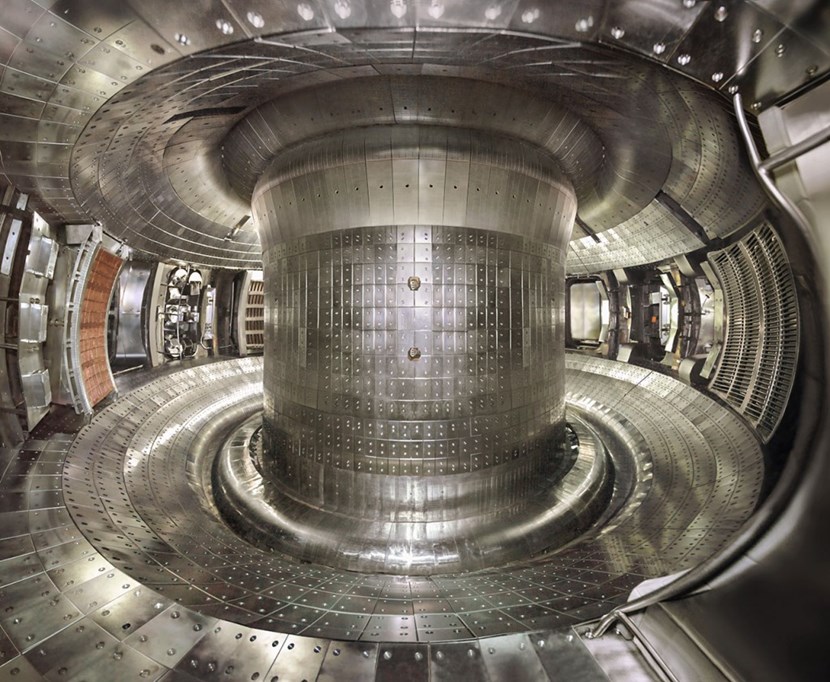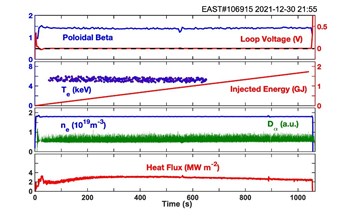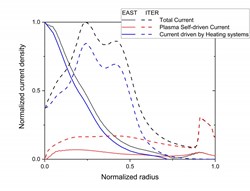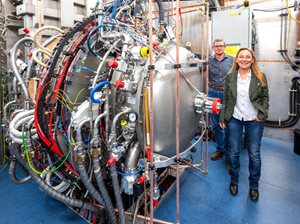ITER NEWSLINE
-
Fusion world
EAST demonstrates 1000-second steady-state plasma
The EAST team and the ITER Science Division
Fusion world | EAST demonstrates 1000-second steady-state plasma
China's Experimental Advanced Superconducting Tokamak (EAST) has made an important advance by achieving stable 1056-second steady-state high-temperature plasma operation, setting a record for long-pulse operation on the night of 30 December 2021. With this result EAST, located at the Institute of Plasma Physics, Chinese Academy of Sciences (ASIPP), has become the first tokamak that can operate with a pulse length in thousand-second scale, with plasma temperatures in the tens of million degrees Celsius and self-driven current, as foreseen for the ITER Q ≥ 5 long-pulse and steady-state scenarios.

A view of EAST's plasma chamber.
A great challenge for fusion energy research is to maintain the confinement of a burning plasma for a sufficiently long duration and with a high duty-cycle. The magnets of superconducting tokamak devices are capable of supporting long-pulse operation; however, to maintain a plasma at high temperature over these timescales, integrated solutions to key technical and physics issues are needed. This concerns, for example, maintaining the temperature of the components in contact with the plasma under control; controlling the plasma magnetic configuration for long durations; or driving current in the plasma with heating and current drive systems to extend the discharge to longer durations that can be maintained by the central solenoid.

Figure 1. EAST's 1056-second steady-state high-temperature plasma discharge. From top to bottom: Plasma normalized pressure (poloidal beta); voltage applied by the central solenoid; electron temperature and injected energy into the plasma; plasma density; and peripheral deuterium light emission and heat flux to the divertor target.
The EAST experiments have demonstrated that such technical and scientific challenges can be resolved. This was achieved in plasmas with dominant electron heating and low input torque driving the plasma current with an actively cooled ITER-like tungsten divertor with the capability to handle a heat flux of up to 10 MWm-2. EAST achieved a fully non-inductive current-driven steady-state plasma with a normalized confinement factor H89 of ~1.3 (i.e., 30% higher than L-mode confinement) and total injected energy into the plasma of 1.73 GJ (see Figure 1). In these plasmas, 70% of the current is driven by the heating and current drive systems while 30% is driven by the plasma itself due to transport processes (bootstrap current) because of the high normalized pressure of the plasma (poloidal beta ~ 1.5). For comparison, in the ITER 10 MA Q ≥ 5 steady-state plasma scenario the poloidal beta is ~ 1.0 and 66% of the current is driven by heating and current drive systems and 33% by the plasma itself (i.e., a very similar proportion to the EAST results, see Figure 2).

Figure 2. Normalized current profiles showing the externally driven currents and the plasma self-driven current for the ITER 10 MA/5.3 T Q ≥ 5 steady-state plasma and for the EAST record-duration plasma shot #106915 of December 2021.
To sustain this plasma it was necessary to control plasma equilibrium and position over long time scales, which is challenging for the magnetic diagnostics since low drifts of the electronics must be maintained. Similarly, large divertor heat fluxes must be handled over long time scales at a level of ~ 3 MWm-2, impurities (particularly tungsten from the divertor) must be prevented from contaminating and cooling down the plasma, and good pumping of the edge plasma neutrals must be maintained to ensure that the plasma density does not rise in an uncontrolled way, terminating the plasma discharge.
All these scientific and technical aspects have been demonstrated on EAST, which was specifically built for demonstrating long-pulse high-performance operation with an ITER-like configuration and heating schemes. Thus, the success of EAST's experiment in maintaining a high temperature plasma beyond 1000 seconds is an important milestone on the way to exploring and controlling plasmas that will be required for ITER and future fusion reactors.
return to the latest published articles









